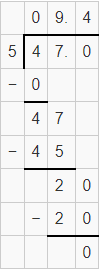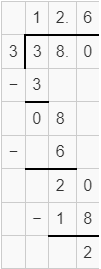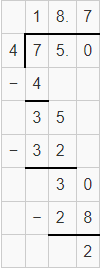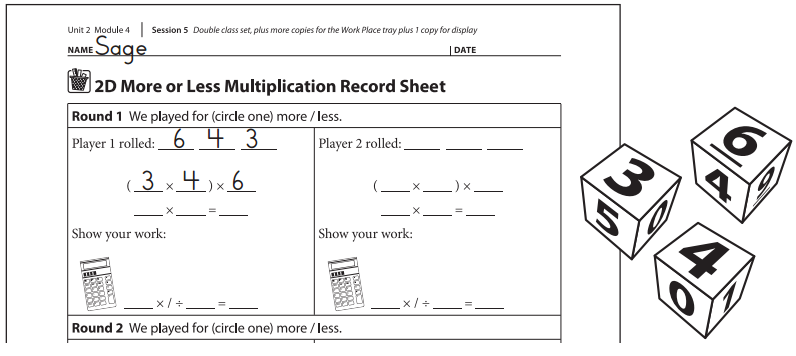Practicing the Bridges in Mathematics Grade 4 Student Book Answer Key Unit 2 Module 4 will help students analyze their level of preparation.
Bridges in Mathematics Grade 4 Student Book Answer Key Unit 2 Module 4
Bridges in Mathematics Grade 4 Student Book Unit 2 Module 4 Session 1 Answer Key
Multiplication Tables
Question 1.
Complete the multiplication tables below.
ex

a.

Answer:
The above table is a multiple of 3.

3 × 5 = 15
3 × 2 = 6
3 × 9 = 27
3 × 3 = 9
3 × 8 = 24
3 × 6 = 18
3 × 7 = 21
3 × 4 = 12
b.

Answer:
The above table is a multiple of 4.

4 × 5 = 20
4 × 2 = 8
4 × 9 = 36
4 × 3 = 12
4 × 8 = 32
4 × 6 = 24
4 × 7 = 28
4 × 4 = 16
c.

Answer:

8 × 5 = 40
8 × 2 = 16
8 × 9 = 72
8 × 3 = 24
8 × 8 = 64
8 × 6 = 48
8 × 7 = 56
8 × 4 = 32
Question 2.
Solve the division problems below.
40 ÷ 5 = ____ 27 ÷ 3 = ____ 16 ÷ 4 = ____ 20 ÷ 5 = ____
64 ÷ 8 = ____ 32 ÷ 4 = ____ 18 ÷ 6 = ____ 9 ÷ 3 = ____
Answer:
40 ÷ 5 = 8

By dividing 40 by 5 we get 8.
27 ÷ 3 = 9

By dividing 27 by 3 we get 9.
16 ÷ 4 = 4

By dividing 16 by 4 we get 4.
20 ÷ 5 = 4

By dividing 20 by 5 we get 4.
64 ÷ 8 = 8

By dividing 64 by 8 we get 8.
32 ÷ 4 = 8

By dividing 32 by 4 we get 8.
18 ÷ 6 = 3

By dividing 18 by 6 we get 3.
9 ÷ 3 = 3

By dividing 9 by 3 we get 3.
Question 3.
CHALLENGE Solve the division problems below.
a. 47 ÷ 5 =
Answer: 9.4

By dividing 47 by 5 we get 9.4
b. 52 ÷ 6 =
Answer: 8.6

By dividing 52 by 6 we get 8.6
c. 82 ÷ 9 =
Answer: 9.1

By dividing 82 by 9 we get 9.1
d. 38 ÷ 3 =
Answer: 12.6

By dividing 38 by 3 we get 12.6
e. 75 ÷ 4 =
Answer: 18.7

By dividing 75 by 4 we get 18.7
Bridges in Mathematics Grade 4 Student Book Unit 2 Module 4 Session 2 Answer Key
Sharing Problems
Question 1.
Kendra and Veronica’s aunt gave them $19 to spend at the store. If they split the money evenly, how much did they each get to spend? Use labeled sketches, numbers, or words to solve this problem. Show all your work.
Answer:
Given,
Kendra and Veronica’s aunt gave them $19 to spend at the store.
19 ÷ 2 = $9.50
Question 2.
Frank had 42 rocks that he wanted to share with his 4 friends. If he gave each friend the same number of rocks (and kept the same number of rocks for himself), how many rocks did each person get? Use labeled sketches, numbers, or words to solve this problem. Show all your work.
Answer:
Given,
Frank had 42 rocks that he wanted to share with his 4 friends.
42 ÷ 4 = 10.5
Thus each friend will get approximately 10 rocks.
Question 3.
CHALLENGE Joe’s grandma lives 36 blocks up the street from Joe. On Saturday, Joe rode his bike two-thirds of the way to his grandma’s house and then realized he forgot the present he was going to give her. Joe rode back to his house, got the present, and rode all the way to his grandma’s house. Then he rode straight home. How many blocks did Joe ride in all? Use labeled sketches, numbers, or words to solve this problem. Show all your work.
Answer:
Given,
Joe’s grandma lives 36 blocks up the street from Joe.
On Saturday, Joe rode his bike two-thirds of the way to his grandma’s house and then realized he forgot the present he was going to give her.
2/3 × 36 = 24 blocks
Joe rode back to his house, got the present, and rode all the way to his grandma’s house.
(1 – 2/3) × 36 = 12 blocks
Then he rode straight home = 36 blocks
Total number of blocks he rode is 24 + 12 + 36 + 36 = 107 blocks
Bridges in Mathematics Grade 4 Student Book Unit 2 Module 4 Session 4 Answer Key
Work Place Instructions 2D Remainders Win
Each pair of players needs:
- 1 Remainders Win Record Sheet to share (Note: There are three pages of Remainders Win Record Sheets. Use a different page each time you play this game.)
- 1 die numbered 4-9
- scratch paper (optional)
- pencils
1. Players each roll the die. The player with the higher number is Player 1. Players write their names on the record sheet.
2. Player 1 circles one of the arrays on the record sheet in pencil and then calculates the product of the multiplication problem. This number will be the dividend.
3. Then Player 1 rolls the 4-9 die to produce the divisor, the number by which the dividend will be divided.
4. Player 1 records the division equation on the record sheet and players work together to find the answer. They circle the remainder, if there is one.

5. Player 2 then repeats the steps with a new array.
6. Players take turns until all 10 arrays are used and 10 division equations are recorded on the record sheet (five for each player).
7. Players find the sums of their remainders. The player with the higher sum wins.
Game Variations
A. Players choose arrays for each other rather than choosing their own.
B. Instead of the higher remainder sum winning, the lower sum wins.
C. Players roll the die first to determine the divisor and then choose an array.
D. Players roll two dice (two 1-6 dice, two 4-9 dice, or one of each), add the two numbers rolled, and divide the array’s product by that number.
Bridges in Mathematics Grade 4 Student Book Unit 2 Module 4 Session 3 Answer Key
Multiplying with Money
Question 1.
Use the arrays of your work. coins to help solve each multiplication problem below. Show all
ex

a.

Answer:
15 × 5 = 75
5 × 3 = 15
5 × 3 = 15
5 × 3 = 15
5 × 3 = 15
5 × 3 = 15
15 + 15 + 15 + 15 + 15 = 75¢

b.

Answer: 105
21 × 5 = 105
7 × 3 = 21
7 × 3 = 21
7 × 3 = 21
7 × 3 = 21
7 × 3 = 21
21 + 21 + 21 + 21 + 21 = 105¢

Question 2.
CHALLENGE Solve the multiplication problems below. Show all your work.
a.

Answer: 310

By multiplying 62 and 5 we get 310
b.

Answer: 315

By multiplying 63 and 5 we get 315
Bridges in Mathematics Grade 4 Student Book Unit 2 Module 4 Session 4 Answer Key
Work Place Instructions 2E More or Less Multiplication
Each pair of players needs:
• a 2E More or Less Multiplication Record Sheet
• 2 dice numbered 1-6
• 1 die numbered 4-9
• a more/less cube
• a calculator
• large base ten grid paper, if desired
1. Players take turns rolling the same die. The player with the higher number goes first.
2. Player 1 rolls the more/less cube to see if more or less is the goal and then circles the word on the record sheet.
3. Player 1 rolls the three numbered dice, records the numbers on the record sheet, and thinks about the best order for multiplying these three numbers.
It may help to move the dice around.
4. Player 1 writes an expression to show the order to multiply the numbers.
The two numbers that will be multiplied first are written in parentheses, with the third number outside the parentheses.

5. Player 1 multiplies the first two numbers inside the parentheses and writes the product, along with the third number, on the next line.
6. Player 1 finds the product and shows his work.
- Players need to find a way to solve the problem using multiplication instead of repeated addition.
- Players can use the base ten grid paper or multiplication facts they know to help.
- Players cannot use the calculator for this part of the game.

7. The Last Toss Option: If a player is not happy with his total, he can choose to roll the 1-6 die once, write the number in the box beside the little calculator, and then multiply or divide the total by that number.
He can use a calculator to help do this part.

8. Player 2 takes a turn rolling the three numbered dice and finding the product.
9. Players compare their totals and circle the winner.
The lower total wins if players rolled “less” at the start of the round. The higher total wins if they rolled “more” at the start of the round.
10. Players begin a new round.
Game Variations
A. Use two 4-9 dice and one 1-6 die instead so that players multiply larger numbers.
B. Use the 2E More or Less Multiplication Challenge Record Sheet. Roll five dice and multiply three of the numbers together and then multiply the other two numbers together. Then decide if you want to add or subtract the two products. The winner is the player who gets closest to 150. For example:
Sage rolled a 5, 4, 8, 3, and 7. She decided to multiply the 3 and 7 and 8, then the 5 and 4. She subtracted the two products.
(3 × 7) × 8 – (5 × 4)
21 × 8 = 168 and (5 × 4) = 20
168 – 20 = 148
Fourth Grade Games
Question 1.
Conrad is playing More or Less Multiplication. He rolls “more” and 4, 7, and 6.
a. How should Conrad order his numbers?
Answer: Given,
Conrad is playing More or Less Multiplication. He rolls “more” and 4, 7, and 6.
The order of his numbers must be 4, 6 and 7.
b. How would you tell Conrad to multiply his numbers?
Answer: Conard is playing more multiplication.
c. Multiply Conrad’s numbers. Show your work.
Answer:
(4 × 6) × 7
24 × 7 = 168
The product of Conard’s numbers is 168.
Question 2.
Mariah is playing Moolah on My Mind. She rolled a 3 and 4 and spun a quarter.
a. Write an expression that represents this problem.
Answer:
b. How much money did Mariah get in this turn? Show your work.
Answer:
Bridges in Mathematics Grade 4 Student Book Unit 2 Module 4 Session 5 Answer Key
Multiplication & Division Practice
Question 1.
Carrie says that she can solve 27 × 20 by first solving 27 × 2 and then multiplying the product of 27 × 2 by 10. Do you agree or disagree? Why?
Answer:
Given,
Carrie says that she can solve 27 × 20 by first solving 27 × 2 and then multiplying the product of 27 × 2 by 10.
27 × 2 × 10 = 540
27 × 20 = 540
Yes, I agree with Carrie.
Question 2.
Tarik has to solve the problem 14 × 30. He is not sure what to do.
a. How would you tell Tarik to solve the problem?
Answer:
Tarik can write the product as 14 × 3 × 10
b. Solve 14 × 30.
Answer:
14 × 10 × 3 = 140 × 3 = 420
Question 3.
There is a new pet store opening in the mall. They just got 52 tropical fish. They want to put 7 of these fish in each aquarium. How many aquariums will they need?
- Use numbers, labeled sketches, or words to solve this problem.
- Write the answer on the line below.
The pet store will need ________ aquariums to hold 52 fish.
Answer:
Given,
There is a new pet store opening in the mall.
They just got 52 tropical fish. They want to put 7 of these fish in each aquarium.
52 × 7 = 364
The pet store will need 364 aquariums to hold 52 fish.